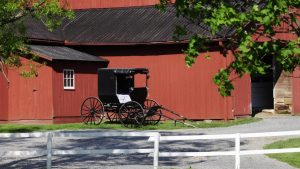 we’re proud to call Berlin, Ohio our home. But we have much more to offer than proximity to Walnut Creek and other authentic Amish experiences. Berlin’s unique history shows how it should be an essential part of any Amish country visit.
we’re proud to call Berlin, Ohio our home. But we have much more to offer than proximity to Walnut Creek and other authentic Amish experiences. Berlin’s unique history shows how it should be an essential part of any Amish country visit.
FOUNDED IN 1816
Berlin is actually the oldest village in Holmes County, Ohio, with its plots laid out on July 2, 1816. The town’s founders named it after their own hometowns of Berlin, Germany and Berlin, Pennsylvania. According to some, Berlin’s location was chosen due to its relatively high elevation — over 1,200 feet — which made it the highest spot in the county.
While the town’s first settlers were primarily of German and Swiss descent and represented a variety of religious groups, the Amish arrived by 1820 and quickly made a large impact on the village with their strong work ethic. Berlin soon became a thriving commercial center, with foundries, tailor and blacksmith shops, sawmills, chair factories, and more. The Berlin Academy opened in the 1860s, while a popular auction played a prominent role in the village’s activities in the early 1900s.
TODAY
Today, Berlin remains a smaller village that holds to its traditions while also embracing the modern world. You can get the full Amish country experience while also enjoying more modern activities like car shows, concerts, and half-marathons. No matter what you have in mind for your trip, Berlin is an essential stop.
 Located in the heart of Amish country, we’re proud to call Berlin, Ohio our home. But we have much more to offer than proximity to Walnut Creek and other authentic Amish experiences. Berlin’s unique history shows how it should be an essential part of any Amish country visit.
Located in the heart of Amish country, we’re proud to call Berlin, Ohio our home. But we have much more to offer than proximity to Walnut Creek and other authentic Amish experiences. Berlin’s unique history shows how it should be an essential part of any Amish country visit.
FOUNDED IN 1816
Berlin is actually the oldest village in Holmes County, Ohio, with its plots laid out on July 2, 1816. The town’s founders named it after their own hometowns of Berlin, Germany and Berlin, Pennsylvania. According to some, Berlin’s location was chosen due to its relatively high elevation — over 1,200 feet — which made it the highest spot in the county.
While the town’s first settlers were primarily of German and Swiss descent and represented a variety of religious groups, the Amish arrived by 1820 and quickly made a large impact on the village with their strong work ethic. Berlin soon became a thriving commercial center, with foundries, tailor and blacksmith shops, sawmills, chair factories, and more. The Berlin Academy opened in the 1860s, while a popular auction played a prominent role in the village’s activities in the early 1900s.
TODAY
Today, Berlin remains a smaller village that holds to its traditions while also embracing the modern world. You can get the full Amish country experience while also enjoying more modern activities like car shows, concerts, and half-marathons. No matter what you have in mind for your trip, Berlin is an essential stop.
 Located in the heart of Amish country, we’re proud to call Berlin, Ohio our home. But we have much more to offer than proximity to Walnut Creek and other authentic Amish experiences. Berlin’s unique history shows how it should be an essential part of any Amish country visit.
Located in the heart of Amish country, we’re proud to call Berlin, Ohio our home. But we have much more to offer than proximity to Walnut Creek and other authentic Amish experiences. Berlin’s unique history shows how it should be an essential part of any Amish country visit.
FOUNDED IN 1816
Berlin is actually the oldest village in Holmes County, Ohio, with its plots laid out on July 2, 1816. The town’s founders named it after their own hometowns of Berlin, Germany and Berlin, Pennsylvania. According to some, Berlin’s location was chosen due to its relatively high elevation — over 1,200 feet — which made it the highest spot in the county.
While the town’s first settlers were primarily of German and Swiss descent and represented a variety of religious groups, the Amish arrived by 1820 and quickly made a large impact on the village with their strong work ethic. Berlin soon became a thriving commercial center, with foundries, tailor and blacksmith shops, sawmills, chair factories, and more. The Berlin Academy opened in the 1860s, while a popular auction played a prominent role in the village’s activities in the early 1900s.
TODAY
Today, Berlin remains a smaller village that holds to its traditions while also embracing the modern world. You can get the full Amish country experience while also enjoying more modern activities like car shows, concerts, and half-marathons. No matter what you have in mind for your trip, Berlin is an essential stop.
